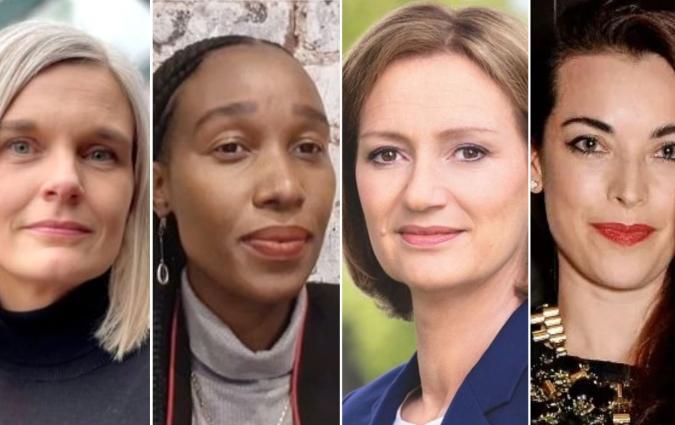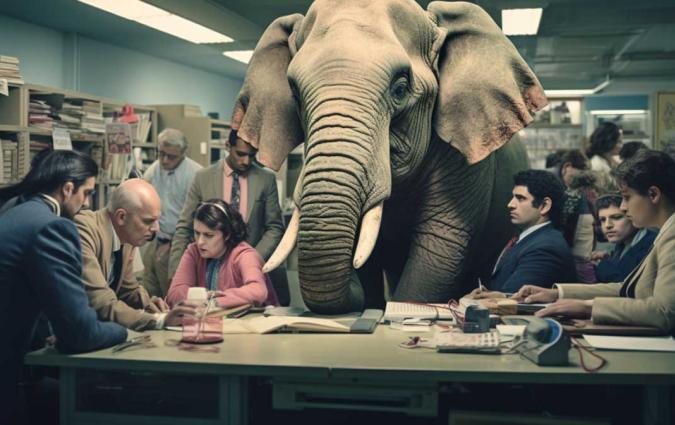In this piece
How to bridge the gender gap in the UK's news camera crews

BBC Cameraperson Maxine Collins capturing an aerial shot from a helicopter above the British Virgin Islands following Hurricane Irma in 2017. Photo: Paul Blake/BBC
In this piece
What is being done to include more women? | 1. Reinforce recruitment efforts | 2. Make pathways for in-house talent | 3. Take steps to retain apprentices | 4. Create a more accommodating workplaceIn the world of news broadcasting, the spotlight shines brightly on those in front of the camera. But what happens off-screen can be just as important in shaping the final story.
In the intricate process of compiling a news piece, teams of two or three people work together in the field. The cameraperson can have an outsized influence, with the power to shape narrative through shot selection, perspective, and editing choices. The cameraperson’s beliefs, assumptions, and connections with their team and interviewee can profoundly influence the storytelling process.
Two female BBC journalists interviewed Jasmine Arbery in November 2020, at the height of a federal trial against the men who chased down and killed her brother, Ahmaud.
Prior to speaking with the BBC, Arbery had given one other interview to a U.S. news outlet where she appeared reserved and uncomfortable, giving brief answers – often with her arms crossed.
The BBC interview was very different: arguably because of who was behind the camera and asking the questions. BBC journalist Chelsea Bailey and Camera/Editor Hannah Long-Higgins told Jasmine Arbery their goal was “to remind the world that her brother was so much more than how he was murdered”.
“Jasmine ultimately agreed to the interview and opened up about her brother in a way that she hadn’t before. I think she felt comfortable being candid because she was also speaking with two women who took the time to connect with her and were close to her age,” Bailey said.
The result was an intimate and powerful story about an older sister fighting to preserve her brother’s memory and for the justice he rightfully deserved.
In short: the camera and equipment can be intimidating or collaborative: it matters who is behind it.
BBC News employs around 150 people worldwide in roles variously known as “camera/editor”, “shoot/edits” or “camera crew” but, as of December 2023, only about 5% are women. This underrepresentation extends to foreign bureaus, where only 4% of camera crews are women.
The imbalance is in no way unique to the BBC: at Sky News and Independent Television News (ITN, who employ camera operators making news for ITV, Channel 4 and Channel 5), only 7% of the camera workforce are women according to figures collected in December 2023.
These statistics have been consistent for many years, meaning that major news events reported on UK television are almost always being framed by a male camera operator.
What is being done to include more women?
Diversity is not just a desirable goal; there are tangible benefits, including improved innovation, less groupthink, and enhancing journalistic storytelling. Different perspectives can help us better connect with audiences, foster creativity, reduce stereotyping, and fulfil the BBC's commitment to a diverse workforce.
Acknowledging this, the BBC has implemented initiatives across recruitment, training, and retention to address the gender imbalance. Job ads use inclusive language and emphasise flexible working hours, and interviews are conducted by gender-diverse panels.
At the BBC Academy, the Broadcast Operator apprenticeship attracts a large pool of candidates and careful thought goes into producing a diverse cohort with huge potential. However, despite these efforts, many recruits leave within a matter of years.
I’ve been filming international network news for the past 30 years – 20 of those at the BBC. I wanted to use my fellowship at the Reuters Institute for the Study of Journalism to take a snapshot of the situation on the ground, collate feedback, and offer new ideas to recruit and retain more women behind the camera.
To do so, I spoke to more than 20 of my camera department colleagues of all genders and interviewed women who left the department, as well as those who chose not to join it – despite having the relevant skills.
I also talked to at least 10 colleagues working in management, the BBC apprentice training scheme, and in the Diversity, Equity, and Inclusion (DEI) team. Finally, I consulted with thought leaders, media researchers and mangers at related news organisations.
My findings are attached in the full PDF report below, but can be summarised in four categories:
1. Reinforce recruitment efforts
Actively seek out skilled female candidates from inside and outside the BBC. Clarify parental policies to dispel misconceptions about the impact on women's careers. Make diversity progress a factor in performance appraisals.
2. Make pathways for in-house talent
Introduce a formal rotation scheme for Video Journalists to experience camera crew roles. Extend rotation opportunities to employees from other departments. Pilot a skills-based deployment scheme to encourage collaboration between different roles.
3. Take steps to retain apprentices
Focus on key junctions where recruits need more support. Many people mentioned the end of the apprentice scheme and entry into the camera department as a time when more structured support is needed.
Provide formal training and mentorship with scheduled feedback during the apprenticeship – ideally by two camera operators already in the department. Continue this once the apprenticeship is complete.
Increase travel during shadowing/training to give a deeper learning experience and more support before embarking on challenging deployments alone.
Pay attention to the interests of the individual and needs of younger staff, and increase the range of attachments offered.
4. Create a more accommodating workplace
Introduce a female camera champion role. This person would highlight opportunities and raise issues with management, liaise with internal or external partners on best practice, and locate female camera talent for available jobs.
Look at the shift structure and assess whether another pattern might work. Shift patterns can contribute to a sense of isolation or difficulty achieving work/life balance.
Clearly outline parental leave allowances and other workplace benefits to address the concerns candidates may have related to family planning.
Use gender neutral job titles: opt for terms like camera crew, shoot/edit, camera operator, rather than cameraman/woman. (This is in practice in recruitment but not followed through on the job.)
To quote Dr Jill Armstrong, lead researcher on Women collaborating with men: “People create culture, and people – individually and collaboratively – can change culture by creating a work environment [that] facilitates opportunities to succeed for diverse groups. […] Inclusive cultures will not simply arrive on their own; we all have to do something differently.”
Gender parity behind the camera is the necessary next step for the BBC if we are to produce nuanced and powerful storytelling and reflect the full range of perspectives that our charter requires. By implementing these recommendations, it is my hope that the BBC can not only address the immediate gender disparity but also create a more inclusive and dynamic department that fosters the growth and retention of diverse talents into the future.



